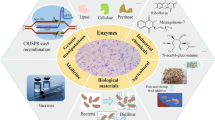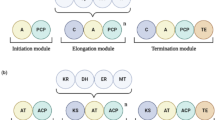Abstract
The present study deals with the mechanism by which plasmid pCED3 interferes with the growth of Bacillus subtilis. Plasmid pCED3 was constructed from pUB110 and pBR322 and contains the lacZ gene attached to the B. subtilis tms promoter. Plasmid derivatives that contain mutations in the tms promoter were used to examine the effect of promoter strength on cell growth, plasmid stability, the amount of plasmid DNA per cell and the activities of plasmid-encoded enzymes, i. e., β-galactosidase and kanamycin nucleotidyltransferase (KNT). Efficient lacZ transcription directed from the tms promoter resulted in reduction in growth rate and plasmid stability without an increase in β-galactosidase activity. The amount of plasmid DNA varied between 6.6 and 12.9 pmol per mg cell protein and showed no clear correlation with the strength of the tms promoter. Transcription from the tms promoter inhibited the expression of the plasmid-encoded kanamycin resistance gene resulting in the reduction of both β-galactosidase activity and growth rate in the presence of kanamycin. These results suggest that the negative effect on B. subtilis growth exerted by pCED3 results at least partly from a decrease in kanamycin resistance by plasmid-bearing cells.
Similar content being viewed by others
References
Adams CW, Hatfield GW (1984) Effects of promoter strength and growth conditions on copy number of transcription-fusion vectors. J Biol Chem 259:7399–7403
Contente S, Dubnau D (1979) Marker rescue transformation by linear plasmid in Bacillus subtilis. Plasmid 2:555–571
Corfield VA, Sugrue JA, Thomson JA (1988) Towards an understanding of hybrid plasmid instability in Bacillus subtilis. In: Thomson JA (ed) Recombinant DNA and bacterial fermentation. CRC Press, Boca Raton, pp 23–44
Donnelly CE, Sonenshein AL (1982) Genetic fusion of E. coli lac genes to a B. subtilis promoter. In: Ganesan A, Hoch J, Chang S (eds) Molecular cloning and gene regulation in bacilli. Academic Press, New York London, pp 63–72
Donnelly CE, Sonenshein AL (1984) Promoter-probe plasmid for Bacillus subtilis. J Bacteriol 157:965–967
Ehrlich SD (1989) Illegitimate recombination in bacteria. In: Berg DE, Howe MM (eds) Mobile DNA. American Society for Microbiology, Washington DC, pp 799–832
Ehrlich SD, Noirot P, Petit MA, Janniere L, Michel B, te Riele H (1986) Structural instability of Bacillus subtilis plasmids. In: Setlow IK, Hollander A (eds) Genetic engineering, vol 8. Plenum, New York, pp 71–83
Gentz R, Langer A, Chang ACY, Cohen SN, Bujard H (1981) Cloning and analysis of strong promoters is made possible by the downstream placement of a RNA termination signal. Proc Natl Acad Sci USA 78:4936–4940
Gruss A, Ehrlich SD (1988) Insertion of foreign DNA into plasmids from Gram-positive bacteria induces formation of high molecular weight plasmid multimers. J Bacteriol 170:1183–1190
Gruss A, Ehrlich SD (1989) The family of highly interrelated single-stranded deoxyribonucleic acid plasmids. Microbiol Rev 53:231–241
Gryczan TJ, Contente S, Dubnau D (1978) Characterization of Staphylococcus aureus plasmids introduced by transformation into Bacillus subtilis. J Bacteriol 134:318–329
Henkin TM, Donnelly CE, Sonenshein AL (1988) Mutations in the consensus sequence in the spacer region of a Bacillus subtilis promoter. In: Ganesan AT, Hoch JA (eds) Genetics biotechnology of bacilli, Academic Press, New York, pp 63–67
Hotchkiss RD (1974) Models of genetic recombination. Annu Rev Microbiol 28:445–468
Kavenoff R (1972) Characterization of the Bacillus subtilis W23 genome by sedimentation. J Mol Biol 72:801–806
Marston OAF (1986) The purification of eukaryotic polypeptides synthesized in Escherichia coli. Biochem J 240:1–12
Nyberg K (1985) Enrichment of plasmid DNA in cell membranes of Bacillus subtilis. FEMS Microbiol Lett 29:311–316
Nyberg K, Palava A, Palava I (1985) Exceptionally high copy numbers of a staphylococcal plasmid in Bacillus subtilis revealed by a sandwich hybridization technique. FEMS Microbiol Lett 29:305–310
Ogasawara N (1985) Markedly unbiased codon usage in Bacillus subtilis. Gene 40:145–150
Pines O, Inouye M (1986) Antisense RNA regulation in prokaryotes. Trends Genet 2:284–287
Sadaie Y, Kenneth BC, Doi RH (1980) Purification and characterization of a kanamycin nucleotidyltransferase from plasmid pUB110-carrying cells of Bacillus subtilis. J Bacteriol 141:1178–1182
Scheer-Abramowitz JS, Gryczan TJ, Dubnau D (1981) Origin and mode of replication of plasmids pE194 and pUB110. Plasmid 6:67–77
Semon O, Rao Movva N, Smith TF, Alama ME, Davies J (1987) Plasmid-determined bleomycin resistance in Staphylococcus aureus. Plasmid 17:46–53
Shivakumar GA, Dubnau D (1978) Plasmid replication in dna Ts mutants of Bacillus subtilis. Plasmid 1:405–416
Shoham Y, Demain AL (1990a) Effect of medium composition on structural stability of Bacillus subtilis containing a recombinant plasmid. Enzyme Microb Technol 12:330–336
Shoham Y, Demain AL (1990b) Stabilization of a plasmid-encoded LacZ phenotype in Bacillus subtilis. Curr Microbiol 20:373–379
Shoham Y, Demain AL (1991) Kinetics of loss of a recombinant plasmid in Bacillus subtilis (in press)
Stueber D, Bujard H (1982) Transcription from efficient promoters can interfere with plasmid replication and diminish expression of plasmid specified genes. EMBO J 1:1399–1404
Viret JF, Alonso JC (1987) Generation of linear multigenome-length plasmid molecules in Bacillus subtilis. Nucl Acids Res 15:6349–6367
Watson TG, Louw ME, Traub JR, Thomson JA (1988) Plasmid instability during scale-up of recombinant DNA-containing bacteria. In: Thomson JA (ed) Recombinant DNA and bacterial fermentation. CRC Press Boca Raton, pp 45–63
Wong EM, Muesing MA, Polisky B (1982) Temperature-sensitive copy number mutants of ColE1 are located in an untranslated region of the plasmid genome. Proc Natl Acad Sci USA 79:3570–3574
Author information
Authors and Affiliations
Rights and permissions
About this article
Cite this article
Shoham, Y., Israeli, E., Sonensheim, A.L. et al. Inhibition of growth of Bacillus subtilis by recombinant plasmid pCED3. Arch. Microbiol. 156, 204–212 (1991). https://doi.org/10.1007/BF00249116
Received:
Accepted:
Published:
Issue Date:
DOI: https://doi.org/10.1007/BF00249116




